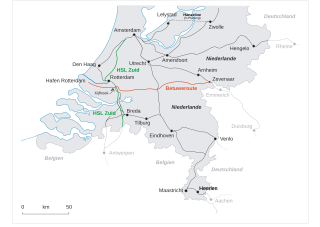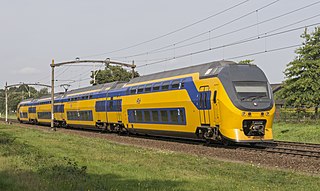
The Netherlands is both a very densely populated and a highly developed country in which transport is a key factor of the economy. Correspondingly it has a very dense and modern infrastructure, facilitating transport with road, rail, air and water networks. In its Global Competitiveness Report for 2014-2015, the World Economic Forum ranked the Dutch transport infrastructure fourth in the world.

Transport in Europe provides for the movement needs of over 700 million people and associated freight.
A classification yard or marshalling yard or shunting yard is a railway yard found at some freight train stations, used to separate railway cars onto one of several tracks. First the cars are taken to a track, sometimes called a lead or a drill. From there the cars are sent through a series of switches called a ladder onto the classification tracks. Larger yards tend to put the lead on an artificially built hill called a hump to use the force of gravity to propel the cars through the ladder.

Europoort is an area of the Port of Rotterdam and the adjoining industrial area in the Netherlands. Being situated at Southside of the mouth of the rivers Rhine and Meuse with the hinterland consisting of the Netherlands, Germany, Belgium and partly France, Europoort is one of the world's busiest ports and considered a major entry to Europe. The port handled 12 million containers in 2015.
This list of train routes in the Netherlands focuses on the routes taken by trains travelling on railway lines in the Netherlands. A list including all stops on the train routes can be found at Dutch railway services.

The Betuweroute is a double track freight railway from Rotterdam to Germany. Betuweroute is the official name, after the Betuwe area through which it passes, but the line is popularly referred to as Betuwelijn, after an older track in the same region. The line extends into Germany as the Oberhausen–Arnhem railway, and it is part of Project No. 5 of the Trans-European Transport Network (TEN-T).

A rail yard, railway yard, railroad yard (US) or simply yard, is a complex series of tracks in a rail network for storing, sorting, or loading and unloading rail vehicles and locomotives. Yards have many tracks in parallel for keeping rolling stock or unused locomotives stored off the main line, so that they do not obstruct the flow of traffic. Cars or wagons are moved around by specially designed yard switchers (US) or shunters, a type of locomotive. Cars or wagons in a yard may be sorted by numerous categories, including railway company, loaded or unloaded, destination, car type, or whether they need repairs. Yards are normally built where there is a need to store rail vehicles while they are not being loaded or unloaded, or are waiting to be assembled into trains. Large yards may have a tower to control operations.

The Maasvlakte is a massive man-made westward extension of the Europoort port and industrial facility within the Port of Rotterdam. Situated in the municipality of Rotterdam in the Netherlands, the Maasvlakte is built on land reclaimed from the North Sea.

The Belt Railway Company of Chicago, headquartered in Bedford Park, IL, is the largest switching terminal railroad in the United States. It is co-owned by six Class I railroads — BNSF Railway, Canadian National Railway, Canadian Pacific Railway, CSX Transportation, Norfolk Southern Railway, and Union Pacific Railroad — each of which uses the switching and interchange facilities of the BRC. Owner lines and other railroads bring their trains to the Belt Railway to be separated, classified, and re-blocked into new trains for departure. The BRC also provides rail terminal services to approximately 100 local manufacturing industries. The company employs about 440 people, including its own police force. Its president is currently Michael J. Grace.

Tinsley was a railway marshalling yard near Tinsley in Sheffield, England, used to separate railway wagons from incoming trains and add them to new trains. It was sited immediately west of the M1 motorway, about one mile north of the Catcliffe junction. It was opened in 1965, as a part of a major plan to rationalise all aspects of the rail services in the Sheffield area; it closed in stages from 1985, with the run-down of rail freight in Britain. It was also the site of Tinsley Traction Maintenance Depot (TMD), which was closed in 1998; at its peak, 200 locomotives were allocated to this depot.

Rail transport in the Netherlands uses a dense railway network which connects nearly all major towns and cities. There are as many train stations as there are municipalities in the Netherlands. The network totals 3,223 route km (2,003 mi) on 6,830 kilometres (4,240 mi) of track; a line may run both ways, or two lines may run on major routes. Three-quarters of the lines have been electrified.

The rail network of Melbourne, Australia, has a significant number of railway lines and yards serving freight traffic. Rail transport in Victoria is heavily focused on Melbourne, and, as a consequence, much of the state's rail freight passes through the metropolitan network.

Barendrecht railway station is a railway station in Barendrecht, Netherlands, located on the Breda–Rotterdam railway between Rotterdam and Dordrecht. Adjacent to the four tracks of this line are two tracks for the HSL-Zuid and three for freight, as part of the Betuweroute freight route to Zevenaar. The nine tracks are in a 1.5 kilometers (0.93 mi) long roofed structure, much of it covered under a layer of earth, to keep noise at bay. On top is a new city park. At the station itself its four tracks, with the platforms, have a glass roof.

Sliedrecht is a railway station in Sliedrecht, Netherlands. The station is located on the MerwedeLingelijn line between Dordrecht and Geldermalsen, part of the Betuwelijn.

Rotterdam Centraal railway station is the main railway station of the city Rotterdam in South Holland, Netherlands. The station received an average of 110,000 passengers daily in 2007. The current station building, located at Station Square, was officially opened in March 2014.

RAIL4CHEM was a German rail freight transport company, and the parent company of a number of European subsidiary rail freight transport companies including rail4chem Benelux B.V. (Rotterdam), the rail4chem transalpin AG (Basel) and Fer Polska S.A. (Warsaw).
The main public transport in the Netherlands for longer distances is by train. Long-distance buses are limited to a few missing railway connections. Regional and local public transport is by bus, and in some cities by metro and tram. There are also ferries.

Dresden-Friedrichstadt station is a freight yard that is, along with the two passenger stations of Dresden Hauptbahnhof and Dresden-Neustadt, a central component of the railway node of Dresden in the German state of Saxony. The station precinct, which is located in the Dresden district of Friedrichstadt, also includes a locomotive depot and a regional passenger station.
The electrification of railway lines in the Netherlands started in 1908 with the Hofplein line. On October 1, 1908, the first electric trains ran here. This railway line, which was built by the Zuid-Hollandsche Electrische Spoorweg-Maatschappij (ZHESM), was supplied with 10 kV alternating current. For the energy supply, the ZHESM had its own power station in Leidschendam. The railway was an economic success. Operating costs were 27 cents per train kilometer, against 42 cents on other railway lines.















